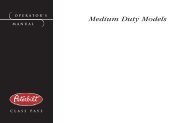PACCAR Engine Aftertreatment Systems-Operator's Manual
PACCAR Engine Aftertreatment Systems-Operator's Manual
PACCAR Engine Aftertreatment Systems-Operator's Manual
Create successful ePaper yourself
Turn your PDF publications into a flip-book with our unique Google optimized e-Paper software.
Diesel Particulate Filter (DPF) System<br />
3<br />
the switch should be in this position.<br />
Placing the switch in the center position<br />
will allow an automatic regeneration to<br />
occur if conditions allow.<br />
Stop (three position switch only)<br />
When STOP is pressed the system will<br />
not regenerate under any conditions.<br />
CAUTION: Do not leave the<br />
switch in the STOP position<br />
unless you need to cancel or<br />
stop a regeneration. Running<br />
the engine with the switch in<br />
the STOP position will result<br />
in increased soot levels in<br />
the DPF and could eventually<br />
cause the engine to derate.<br />
<strong>Aftertreatment</strong> System Warning<br />
Lamps<br />
ATS specific warning lamps and<br />
indicator symbols are located on the<br />
main gauge cluster.<br />
Diesel Particulate<br />
Filter (DPF) Warning<br />
Lamp Symbol<br />
High Exhaust System<br />
Temperature (HEST)<br />
Warning Lamp<br />
Symbol<br />
Functionality / Notification<br />
Information<br />
The ATS will regenerate the DPF by<br />
using hot exhaust gases normally<br />
generated by the engine. This<br />
typically occurs during highway<br />
operation, is referred to as a "Passive"<br />
Regeneration, and is transparent to<br />
the operation of the vehicle.<br />
Occasionally, the exhaust gases<br />
are not hot enough for passive<br />
regeneration. When this occurs,<br />
the ATS will regenerate the DPF by<br />
increasing the exhaust temperature.<br />
This is referred to as an "Automatic"<br />
Regeneration and is also transparent<br />
to vehicle operation. An Automatic<br />
Regeneration event typically lasts 30<br />
minutes. During and shortly after the<br />
event, the exhaust gases from the DPF<br />
may reach temperatures in excess of<br />
650° C (1200° F). See the information<br />
in the table below on probable causes<br />
and recommended actions related<br />
3-6

















